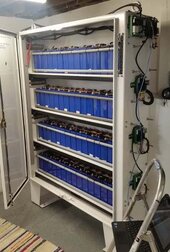richard cabesa
New Member
- Joined
- Mar 16, 2021
- Messages
- 175
OK , I‘m a dummy so tread lightly.
I have a 600AH battery pack and a 2000 watt inverter. 250 A class t fuse and all wiring should handle 300A plus. So unless I manage to somehow pull beyond 250A for some period of time, I should be covered?
But. . .
What else is this class T fuse protecting?
Drop a pipe wrench across the main battery terminals?
Positive wire fall out of the inverter and land on the negative buss bar?
Dead short from what to what?
I have a 600AH battery pack and a 2000 watt inverter. 250 A class t fuse and all wiring should handle 300A plus. So unless I manage to somehow pull beyond 250A for some period of time, I should be covered?
But. . .
What else is this class T fuse protecting?
Drop a pipe wrench across the main battery terminals?
Positive wire fall out of the inverter and land on the negative buss bar?
Dead short from what to what?



